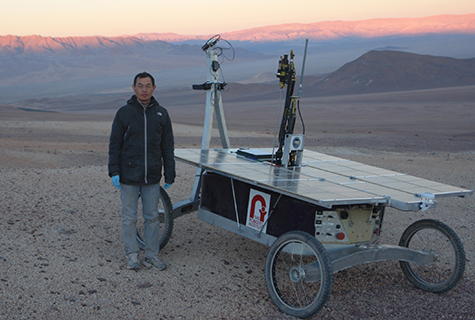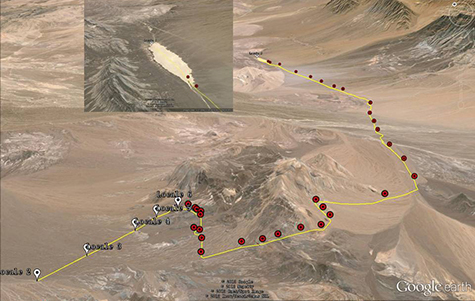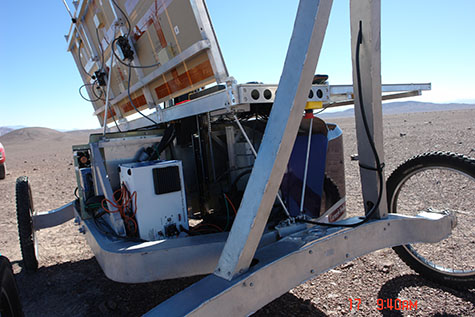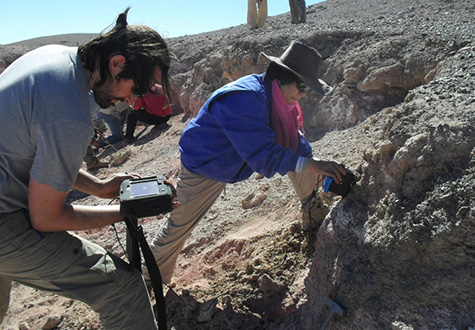
A film director looking for a location where a movie about Mars could be shot might consider the Atacama Desert, a strip of land on the coast of South America west of the Andes that is one of the harshest landscapes on the planet. Due to the accidents of its geography, the Atacama is the driest place on Earth. Some scientists believe there was no rain to speak of in part of the Atacama between 1570 and 1971. With little moisture in the air, its salt lakes, sand dunes and lava flows broil or freeze and are blasted by ultraviolet radiation.
The conditions make the Atacama a splendid place to test instruments for future Mars missions.
“If you’re practicing to find life on Mars, you don’t want to go to a lush environment,” said Alian Wang, PhD, research professor in the Department of Earth and Planetary Sciences in Arts & Sciences at Washington University in St. Louis and a participant in NASA’s ASTEP program to advance the technology and techniques used in planetary exploration.

In June, under the auspices of an ASTEP project led by the Carnegie Mellon University Robotics Institute, a rover named Zoë set out into the Atacama. Together with a rover team led by David Wettergreen, PhD, Zoë spent the next two weeks traveling between waypoints with interesting geology and analyzing soil samples, both ones from the surface and ones dredged up from deep underground.
Subsurface samples pulled up by a meter-long drill and dumped into sample cups carried by a carousel were examined by a laser Raman spectrometer called the Mars Microbeam Raman Spectrometer, or MMRS.
Wang, the principal investigator for the MMRS, was part of the science team led by planetary scientist Nathalie Cabrol, PhD, of the SETI Institute Carl Sagan Center/NASA Ames Research Center. Wang helped oversee the operation from her office in St. Louis via satellite imagery and teleconferences. Her colleague Jie Wei, PhD, a research scientist in earth and planetary sciences, followed the rover in the Atacama, returning each night to sleep in a mining camp.

Ready for prime time
The MMRS in its current compact, robust configuration is the culmination of 18 years of work at WUSTL and the Jet Propulsion Laboratory (JPL), led first by former WUSTL professor Larry Haskin, and now by Wang.
The MMRS originally was scheduled to ride on the Mars Exploration Rovers (MER) Spirit and Opportunity but after NASA lost two missions on approach to Mars — the Polar Lander and the Climate Orbiter — the MER rovers were downsized and offloaded. The Raman spectrometer, because it was the newest analytical instrument on the rovers, was a casualty of this process.

(Credit: A. Wang)
However, it is now the top candidate among instruments being considered for a 2020 mission to Mars and Wang has received $3 million from NASA to make sure that it will be mission ready.
What’s special about laser Raman spectroscopy? The spectrometer shines a laser on the sample and measures the energy of the photons the sample scatters back. “Compared to other spectroscopies,” Wang said, “Raman spectroscopy returns a very clear spectrum. So if you analyze a mixture (rock or soil) you see peaks for each mineral phase and organic molecule. You don’t have to do complicated spectral processing to identify what’s in the sample. So compared to other spectroscopies, it is very diagnostic.”
Don’t fail me now
The journeys in the Atacama are intended to test the MMRS (and other instruments) until they fail. If a power system is going to fail on Mars, it will probably fail as well in the Atacama. And far better it should fail while still Earth-bound, than when it is 34 million miles away on the Martian surface.
Last year, Wang was part of a team that tested instruments in the desert, without the rover, boring holes with hand-held equipment and operating the instruments manually.
Wang was the PI for three of the instruments. “We found some problems we never expected,” she said.
“The heat generated by the Raman spectrometer’s detector is dissipated by a cooling fan. When we came to the Atacama we were sometimes as high as 4,500 meters (14,800 feet) above sea level. The air is so thin at that altitude, the fan labored to get rid of the heat. That’s one lesson we learned.”
“Of course it will be different on Mars,” she said, “where the atmosphere is much thinner, but we learned where the instrument is vulnerable.”

This year, Zoe carried two WUSTL instruments: the Raman spectrometer and a UV-stimulated fluorescence imager called BUF.
“The ‘landing site’ was paved with pebbles,” Jie said. “That was the first thing I saw, and I thought it was going to be easy. But it turned out to be rougher than I thought. We crossed three dry river beds and a boulder field before we arrived at our final destination, a dried lake bed.”
To the scientists’ delight, despite all the jolting and jiggling, the MMRS worked perfectly and remained stable in optical alignment and analytical performance throughout the trip. “We had very nice spectra,” Jie said. He brought all the samples back so that they could be re-run in the lab and the lab data could be compared with data from the field.
On the other hand, the scientists discovered a bug in the fluorescence imager. It had trouble receiving commands from the rover, and despite a valiant effort by lead engineer James Lambert, PhD, at the Jet Propulsion Laboratory to fix the imager before the desert sortie, Jie had to operate it manually. “This is something we still need to work on,” Wang said.
Both discoveries were invaluable since they will allow the team, which is now preparing for a third and final test run in the Atacama in 2014, to make sure these problems don’t occur on Mars.
It’s alive!
Jie, who is trained as a physicist and had never been in the field before, was awed by the Atacama, but also impressed by its hostility to life. Asked whether he saw any signs of life, he replied, “Only the bones of a donkey that had probably died from thirst” and the occasional Chilean journalist. The skin of his hands cracked, he was covered with grit and even though he slept in a bed at night, he sometimes had to shiver himself warm. And he worried about the instruments, especially when the rover was trying to traverse a rubble field or the multimillion-dollar spectrometer was left alone in the desert at night.
“Mars is not livable for humans right now, so it is appropriate the Mars analog is not human-friendly,” said Wang.
But just because it is hard on human beings does not mean it is inhospitable to microbes. The Atacama soil tests done last year confirmed the presence of microorganisms in the desert soils. The presence of life in the Atacama does not, of course, guarantee its presence on Mars. But it does show that if there is subsurface life, the instruments will be able to detect it.